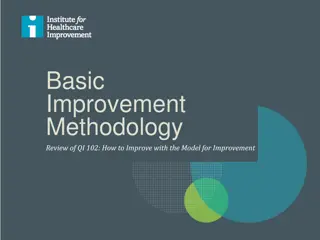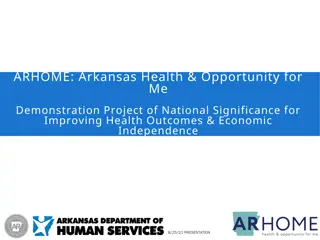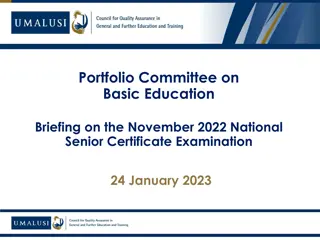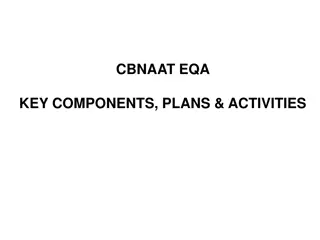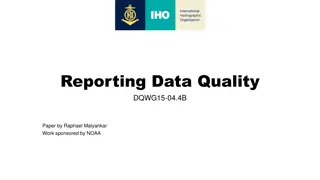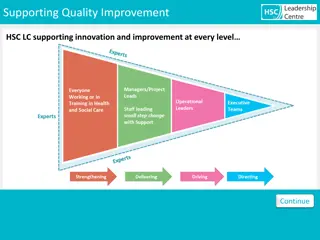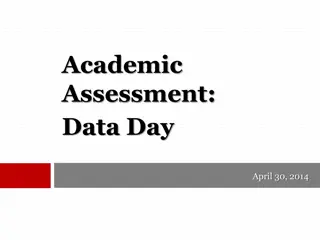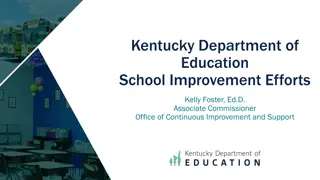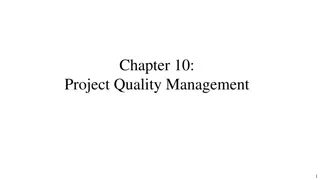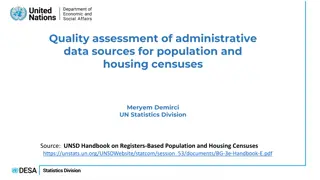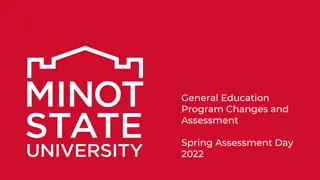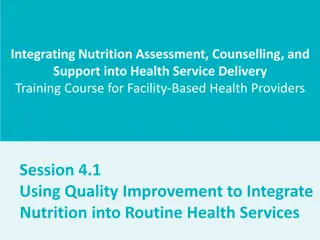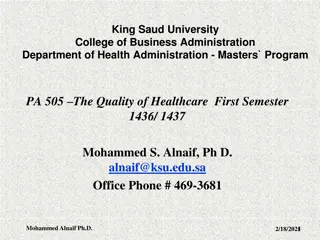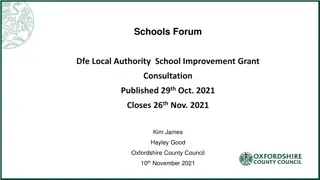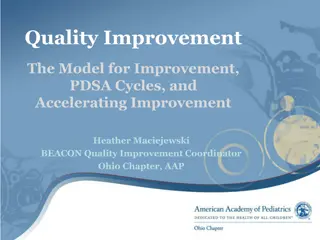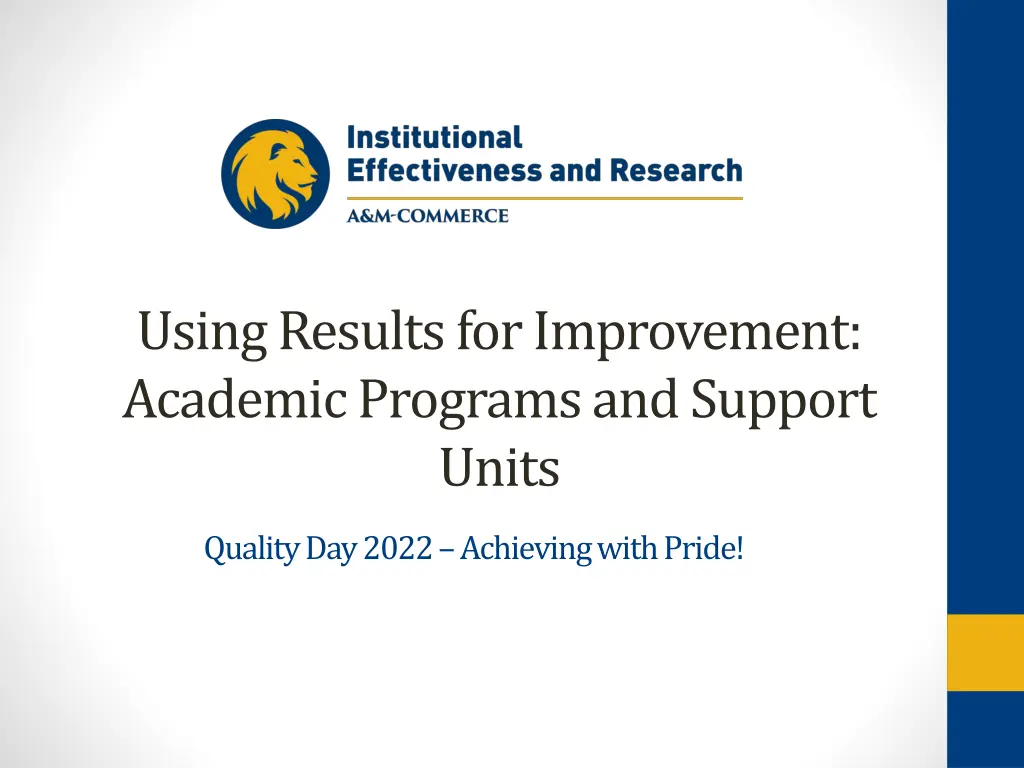
Achieving Quality Improvement Through Results Analysis in Academic Programs
Learn how to utilize data analysis to improve academic programs and support units' quality by identifying expected outcomes, assessing achievements, and seeking improvement based on results. Discover the importance of analyzing data, setting goals, and reporting results to enhance student learning outcomes and overall program effectiveness.
Download Presentation

Please find below an Image/Link to download the presentation.
The content on the website is provided AS IS for your information and personal use only. It may not be sold, licensed, or shared on other websites without obtaining consent from the author. If you encounter any issues during the download, it is possible that the publisher has removed the file from their server.
You are allowed to download the files provided on this website for personal or commercial use, subject to the condition that they are used lawfully. All files are the property of their respective owners.
The content on the website is provided AS IS for your information and personal use only. It may not be sold, licensed, or shared on other websites without obtaining consent from the author.
E N D
Presentation Transcript
Using Results for Improvement: Academic Programs and Support Units Quality Day 2022 Achieving with Pride!
Agenda I. II. Analyzing data III. Using results to develop an action plan Reporting data
The institution identifies expected outcomes, assesses the extent to which it achieves these outcomes, and provides evidence of seeking improvement based on analysis of the results for student learning outcomes for educational programs. each of its
Goals when analyzing data When analyzing data for program assessment, our goals are to 1. Make sense of the information 2. Summarize the information in a way that provides feedback on achievement of student learning, goals or that responds to questions unit staff want answered 3. Provide information that informs faculty or unit staff as they decide how to respond to results 4. Document a clear plan for how the results can be used to seek improvements
Reporting Results Assessment Method: Student Evaluations Students will be evaluated by an internship supervisor at their internship site and scored on 12 demonstrations of skills on a scale of 1 (insufficient) to 5 (exemplary). Standard of Success: 85% of students will be rated a 3.0 or higher on ability to formulate a plan. Results: 26 students in internships were evaluated by their internship supervisors. 50% of student interns were rated a 3 or higher on ability to formulate a plan. Results are aligned with SLOs, assessment methods, and standards of success. Student Learning Outcome: Graduating students will be able to formulate a plan which incorporates alternative solutions to complex problems in a social-environmental context.
Reporting Results Assessment Method: Survey Dining Services will distribute a survey each November to faculty, staff, and students to assess satisfaction and feedback on dining services and food offerings. Agreement questions will be rated on a 4 pt scale (1 = Strongly Disagree; 4 = Strongly Agree) Standard of Success: 80% of respondents will Agree or Strongly Agree that they are able to access food at on-campus dining locations which meets their dietary needs. Results: 64.55% of respondents indicated that they Agreed or Strongly Agreed that they are able to access food which meets their dietary needs. 584 surveys were completed. Provide sample/population size (number assessed). Goal: Visitors to University dining locations will be able to access food which meets their dietary needs.
Reporting Results Assessment Method: Student Evaluations Students will be evaluated by an internship supervisor at their internship site and scored on 12 demonstrations of skills on a scale of 1 (insufficient) to 5 (exemplary). Standard of Success: 85% of students will be rated a 3.0 or higher on ability to formulate a plan. Results: 26 students in internships were evaluated by their internship supervisors. 50% of student interns were rated a 3 or higher on ability to formulate a plan. A breakdown of results by performance level appears in the attached table. Provide descriptive data (e.g., headcount, percentage, average, median, mode, etc.) Student Learning Outcome: Graduating students will be able to formulate a plan which incorporates alternative solutions to complex problems in a social-environmental context.
Representation of Data Types of Data Presentations of Data Narrative description Charts and Graphs Tables Displaying Current results Breakdown of performance levels Historical comparison Number assessed/sample or population size Local Methods Headcount Percentage Mean/Average Dollar amounts Response times External or Standardized Methods Median Range Percentile Statistical analysis Comparison to benchmarks
Analyzing Results Results: 26 students in internships were evaluated by their internship supervisors. 50% of student interns were rated a 3 or higher on ability to formulate a plan. A breakdown of results by performance level appears in the attached table. Our students have performed below the standard of success on this learning outcome since the beginning of this assessment in 2016- 17. Historical comparison appears in the attached chart. Modifications to curriculum and pedagogy have not been successful in better preparing students to formulate a plan in an applied setting. Discussions with internship supervisors indicate that students struggle to produce a clear plan unless given specific instructions. Follow Up on Previous Year Action Plan: Program faculty have added courses assignments and additional lecture time dedicated to how to create and document resource plans in NRMT 548. However, the results do not suggest these have significantly impacted performance. Discussion of results are clear, concise, objective, and substantive.
Analyzing Results Standard of Success: 80% of respondents will Agree or Strongly Agree that they are able to access food at on-campus dining locations which meets their dietary needs. Conclusion: Standard of Success Not Met Results: 64.55% of respondents indicated that they Agreed or Strongly Agreed that they are able to access food which meets their dietary needs. 584 surveys were completed. See the attached documentation for a breakdown of results. This result falls below the standard of success and is similar to results from prior years (2018 results showed a 61% agreement level). There is still a challenge in both offering foods which align with specific dietary restrictions (vegetarian, vegan, gluten-free, etc.) as well as in helping visitors locate these foods when served. Results conclusion identified (e.g., Standard of Success Met, Standard of Success Not Met, Inconclusive) are aligned with results provided.
Activity #1 For each example provided, select the rubric rating which best applies - Revise/Acceptable/Excellent [see Qualtrics QR Code]
Activity Example 1 Student Learning Outcome: Graduating students will be able to apply theoretical perspectives in psychology to the analysis of personal, social, and organizational issues. Assessment Method: Written Assignment/Essay Students in PSY 340 will be assigned an essay analyzing contemporary topics in psychology through a theoretical lens. Essays will be scored on a five point rubric (1=unsatisfactory; 5=exceptional). Standard of Success: 90% of students receive an overall rubric rating of 3 out of 5 or more. Conclusion: Standard of Success Met Results: The average rubric rating was 3.5 (n = 52).
Use of Results Action plans are presented when standards of success are not met, there are inconclusive results, or when standards are met but data indicate changes are needed to curriculum or pedagogy.
Results: 26 students in internships were evaluated by their internship supervisors. 50% of student interns were rated a 3 or higher on ability to formulate a plan. A breakdown of results by performance level appears in the attached table. Our students have performed below the standard of success on this learning outcome since the beginning of this assessment in 2016- 17. Historical comparison appears in the attached chart. Modifications to curriculum and pedagogy have not been successful in better preparing students to formulate a plan in an applied setting. Discussions with internship supervisors indicate that students struggle to produce a clear plan unless given specific instructions. Follow Up on Previous Year Action Plan: Program faculty have added courses assignments and additional lecture time dedicated to how to create and document resource plans in NRMT 548. However, the results do not suggest these have significantly impacted performance. Action plans are clearly based on assessment results, and assessment results are cited in the action Action/Use of Results: Because results show that only 50% of students are achieving mastery of the SLO, the NRMT curriculum committee met to review a curriculum map for the program and identified two additional required courses where content related to plan formulation can be added.
Student Learning Outcome: Graduating students will be able to formulate a plan which incorporates alternative solutions to complex problems in a social-environmental context. Results: 26 students in internships were evaluated by their internship supervisors. 50% of student interns were rated a 3 or higher on ability to formulate a plan. A breakdown of results by performance level appears in the attached table. Our students have performed below the standard of success on this learning outcome since the beginning of this assessment in 2016- 17. Historical comparison appears in the attached chart. Modifications to curriculum and pedagogy have not been successful in better preparing students to formulate a plan in an applied setting. Discussions with internship supervisors indicate that students struggle to produce a clear plan unless given specific instructions. Follow Up on Previous Year Action Plan: Program faculty have added courses assignments and additional lecture time dedicated to how to create and document resource plans in NRMT 548. However, the results do not suggest these have significantly impacted performance. Actions are aligned with the learning outcomes. Action/Use of Results: Because results show that only 50% of students are achieving mastery of the SLO, the NRMT curriculum committee met to review a curriculum map for the program and identified two additional required courses where content related to plan formulation can be added.
Action plans are specific and clear (i.e., who is responsible, what is to be done, when implemented, where implemented, and how implemented.) Action/Use of Results: Because results show that only 50% of students are achieving mastery of the SLO, the NRMT curriculum committee met to review a curriculum map for the program and identified two additional required courses where content related to plan formulation can be added. NRMT 520 will add a case study problem which will include a planning component. NRMT 524 will adopt a new textbook which includes a chapter on policy and planning for forest management. The changes will be implemented beginning Fall 2020. The program coordinator is responsible for working with course instructors to implement the new textbook and case study problem.
Completing Your IE Report The detail you provide in these spaces will help provide evidence of seeking improvement based on analysis of the results
Resources IE Resources @ www.tamuc.edu/ier Office of Institutional Effectiveness

